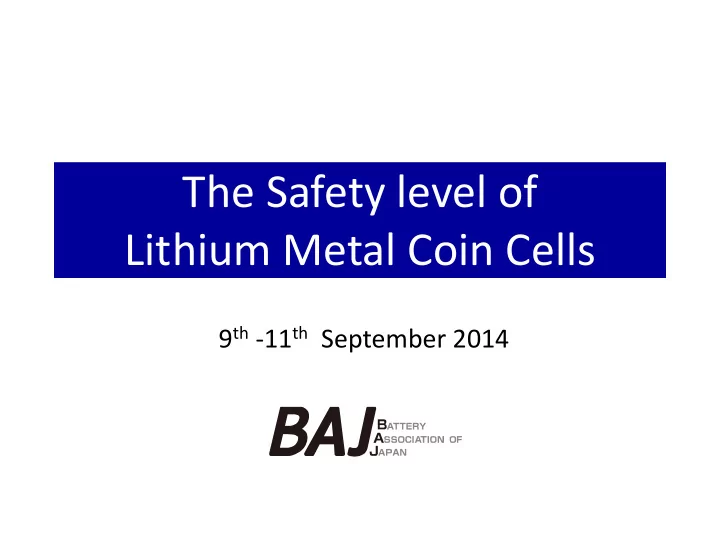

The Safety level of Lithium Metal Coin Cells 9 th -11 th September 2014
1. Structure of the lithium metal coin cell 2. Test outline for external & internal short circuit (UN T-5 & T-6) 3. The Safety level of Japanese coin cells (Already reported data) 4. The Safety level of coin cells collected worldwide (A new report)
1. Structure of the lithium metal coin cell Negative terminal Separator Lithium Gasket Manganese dioxide Positive terminal Coin (Button) : Large electric current does not flow because of small electrode area.
2-1. Test outline of External short circuit (UN T-5) This test is based on UN Manual of Tests and Criteria 5 th revised edition Amendment 1, Part Ⅲ subsection 38.3. Thermostat Chamber ■ Test Condition ・ Unused cell (Fresh) ・ Atmosphere: 55 ± 2 ℃ ・ Circuit Resistance : <0.1Ω ■ Requirements ・ Temp. of cell : <170 ℃ ・ No Explosion , No Rupture , No Fire
2-2. Test outline of Crush (UN T-6) This test is based on UN Manual of Tests and Criteria 5 th revised edition Amendment 1, Part Ⅲ subsection 38.3. This test simulates mechanical abuse from a crush that can result in an internal short circuit. ■ Test Condition ・ Unused cell (Fresh) ・ Crush Speed:1.5cm/s ・ Continue until either; -Pressure : 13 ± 0.78kN -Drop of Voltage :>100mV -Compressibility:>50% ■ Requirements ・ Temp. of cell : <170 ℃ ・ No Explosion, No Fire
3. External & Internal short circuit (Japanese cells) UN-T5 UN-T6 External short circuit Crush < 0.1Ω 13kN Test 55 ± 2 ℃ 20 ± 5 ℃ No Explosion No Explosion CR2032 Results No Fire No Fire made by Japanese 58 ~ 60 ℃ Less than 30 ℃ MAX Temp. manufacturers (+5 ℃ increase) (+10 ℃ increase) As large electric current does not flow in a coin battery, temperature does not increase in most cases, therefore self-ignition does not happen.
4-1. Lithium Metal Coin Cells Collected Worldwide The most common CR type (Li/MnO2) lithium metal coin cells were collected worldwide to evaluate the safety level. These were purchased through the open market (shop, internet ,etc.) from around the world. CR2477 has the highest capacity, CR2032 is the most popular size. CR2477 CR2450 CR2032 Amount of Li 0.29g 0.18g 0.06g The number of models made by 2 3 3 Japanese manufacturers The number of models made by 5 19 28 other countries’ manufacturers Total 7 22 31 Every cell was assigned a sample number according to the brand and manufacturer.
4-2. Test Results of External Short Circuit (Worldwide collected CR2477(Li 0.29g)) Temperature of every cell increased within 10 ℃ , and below 170 ℃ . Neither explosion, rupture or fire were observed. CR2477(Li 0.29g)_55 ℃ 80 No.24 70 Temperature(degree C) No.30 60 No.31 50 No.32 No.54 40 JPN-A 30 JPN-C 20 0 10 20 30 40 50 60 Time(min)
4-3. Test Results of External Short Circuit (Worldwide collected CR2477,CR2450,CR2032) Temperature of every cell increased within 10 ℃ , and below 170 ℃ . Neither explosion, rupture or fire were observed. CR2477(Li 0.29g) CR2450(Li 0.18g) CR2032(Li0.06g) No.19 CR2477(Li 0.29g)_55 ℃ CR2450(Li 0.18g)_55 ℃ No.21 No.22 80 80 No.23 No.24 No.24 70 70 Temperature(degree C) at Temperature(degree C) No.25 No.30 No.26 60 60 No.27 Not No.31 No.28 55 ℃ No.29 50 50 No.32 No.30 evaluated No.31 No.54 40 40 No.33 (T-5) No.34 JPN-A No.35 30 30 JPN-C No.52 No.53 20 20 No.54 0 10 20 30 40 50 60 0 10 20 30 40 50 60 JPN-A Time(min) Time(min) JPN-B No.1 No.19 No.2 CR2032(Li 0.06)_RT CR2477(Li 0.29g)_RT CR2450(Li 0.18g)_RT No.3 No.21 No.4 No.22 80 No.5 80 80 No.6 No.23 No.7 No.24 70 No.8 70 70 Temperature(degree C) No.30 No.25 Temperature(degree C) No.9 Temperature(degree C) No.10 No.26 No.11 No.31 60 at 60 60 No.27 No.13 No.14 No.28 No.32 No.15 No.29 No.16 50 50 50 No.17 No.30 No.54 No.18 RT No.31 No.19 40 40 40 JPN-A No.20 No.33 No.21 No.34 No.22 JPN-C 30 30 No.35 30 No.23 No.24 No.52 No.33 No.53 No.35 20 20 20 No.51 No.54 0 10 20 30 40 50 60 No.52 0 10 20 30 40 50 60 0 10 20 30 40 50 60 JPN-A No.53 Time(min) Time(min) Time(min) JPN-A JPN-C JPN-B
4-4. Test Results of Crush (Worldwide collected CR2477(Li 0.29g)) Temperature of every cell increased within 10 ℃ , and below 170 ℃ . Neither explosion or fire were observed. CR2477(Li 0.29g) _ Crush 35 No.24 Each cell was crushed to 13kN. 30 No.30 Temperature (°C) No.31 25 No.32 20 No.54 JPN-A 15 -10 0 10 20 30 40 50 60 Time (min)
4-5. Test Results of Crush (Worldwide collected CR2450,CR2032) Temperature of every cell increased within 10 ℃ , and below 170 ℃ . Neither explosion or fire were observed. CR2450(Li 0.18g) CR2032(Li 0.06g) No.1 CR2032(Li 0.06g) _ Crush CR2450(Li 0.18g) _ Crush No.2 No19 No.3 35 No21 No.4 35 No.5 No22 No.6 No23 No.7 No.8 No24 No.9 30 30 Temperature( ℃ ) No25 Temperature( ℃ ) No.10 No.11 No26 No.13 No27 No.14 No28 No.15 25 25 No.16 No29 No.17 No30 No.18 No.19 No31 No.20 20 20 No33 No.21 No.22 No34 No.23 No35 No.24 No.33 No52 15 15 No.35 No53 No.51 -10 0 10 20 30 40 50 60 No54 -10 0 10 20 30 40 50 60 No.52 No.53 JPN-A JPN-A Time(min.) Time(min.) JPN-B Each cell was crushed to 13kN.
Conclusions Lithium metal coin cells collected worldwide made by other countries' manufactures showed the same safety level as Japanese coin cells. A lithium metal coin cell does not create high temperature by itself, and does not reach thermal runaway by itself.
Recommend
More recommend